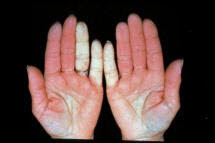How to recognize and deal with a lupus flare up?
So, you’ve been diagnosed with lupus, and you’ve no idea where it came from, but you’ve been told by your doctor that the symptoms you’ve experienced are consistent with the lupus disease. It’s time to take stock of what lupus is, what symptoms you might experience, and how to best treat a flare up.
Can lupus be categorized?
As your doctor will have explained to you, lupus is a disease that affects the autoimmune system by making previously healthy cells attack each other and cause a whole range of lupus symptoms to appear on and in your body. You could describe lupus as being opposite to HIV which actually destroys your autoimmune system, one difference being that HIV can be spread and lupus cannot. lupus may just affect your body at skin-deep level or it may make cells in your internal organs swell up too. You may be lucky and your lupus may stick at doing just one thing, or you could experience a growing number of symptoms. If your lupus is consistent, you’ll be able to work out a great plan of treatment which in most cases can make the world of difference to your life with lupus. But sometimes, lupus attacks a new part of the body, or after a lull, decides to flare up. So the thing to know is how and when to treat a new symptom or an autoimmune flare up.In systemic terms, the lupus disease is one that causes inflammation. Lupus has the nickname ‘the disease with a thousand face’ as a mystery disease that continues to keep doctors in the dark. The term lupus masks a whole range of possible symptoms. They can include decreased energy, weakness, fever, nausea, diarrhea, muscle and joint pain, chest pain, bruising, loss of appetite, weight loss, and a distinctive red, butterfly-shaped rash across the nose and cheeks, mouth sores, joint swelling, hair loss, changes in personality, seizures, and a coin-shaped, red skin rash elsewhere on the body that is aggravated by sunlight. Your kidneys, lungs and blood vessels may end up damaged if your lupus is not under control, or if it has been going on for some time.
How to recognize a new symptom or flare up?
Lupus can be controlled, but you have to take fast action to avoid the worst of lupus flare ups; the times when lupus really takes control of your life, and makes you miss work, school, shopping trips, etc. Flare ups can be controlled by identifying and acting on your trigger points. In some, it could be as simple as exposure to the sun that causes the sudden development of a rash, and then possibly other symptoms. In others, an infection such as a cold or a more serious infection does not get better, and then complications arise. As a disease, lupus repeats itself, often displaying the same sequence of symptoms. So if you recall the first flare up, you will be less trouble recognizing the next. Persistent weakness and fatigue, aching and loss of appetite, hair loss and rashes, all point towards a reactive autoimmune system playing tricks on you.How to treat a flare up?
If you think you have a combination of symptoms that adds up to a lupus flare up, go and see your doctor who might offer medications to control inflammation. But just as importantly, you need to care for yourself and avoid stress. It’s easy to become more stressed if you encounter a flare up situation, but the best response is a controlled calm, coupled with the support of friends and family. And there are many natural things you can do to reduce inflammation in your body. Exercise, eat well and avoid direct sunlight. Take vitamins and other health supplements that have been known to limit lupus flare up damage, and above all, get plenty of sleep and be flexible with your daily routine. You need to take time to allow your lupus to get back under control again.Source: http://www.articlealley.com/article_194017_17.html
Subscribe to:
Post Comments (Atom)



Post a Comment